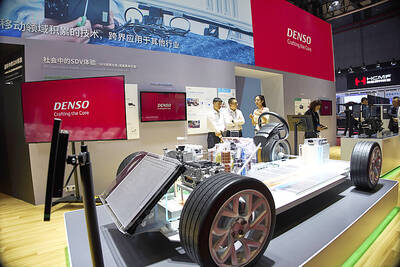TPK Holdings Co (宸鴻), which supplies touchpanels for Apple Inc’s iPad, aims to cut its operating expenses by 2 percent to 5 percent over the next three months at the earliest as new TPK chief executive officer Michael Chung (鍾依華) plans to get the firm out of the woods.
“It will take three to six months to hit the target,” Chung told a media gathering yesterday after his appointment was approved by the company’s board earlier in the day.
TPK booked NT$2.48 billion (US$81.31 million) in operating expenses for last quarter, down slightly from NT$2.64 billion a quarter ago.

Photo: CNA
To improve operating expenses, Chung said the priority would be to boost the production yield of its new touch-on-lens technology, which would help save material and labor costs. Yields are not yet stable, only hitting 80 percent occasionally, he said.
Chung is taking the helm from Tom Sun (孫大明), who was yesterday promoted to vice chairman.
However, TPK reported quarterly losses of NT$241 million in the past quarter after its operating profit margin fell into negative territory, at minus-1 percent, for the first time in the company’s history.
An increase in labor costs and unfulfilled customer orders also led gross margin to fall to an all-time low of 6.6 percent last quarter from 8.9 percent in the previous quarter and 12.4 percent a year ago.
The company has experienced ups and downs in its business since Apple stopped using its touchpanels when it introduced its iPhone 5 series in 2012.
Chung, 53, worked for Hon Hai Precision Co (鴻海精密) for 15 years and was in charge of smartphone assembly for Apple. His new job at TPK has triggered speculation that the firm may gain more orders from the US electronics giant. Hon Hai is a major iPhone assembler.
“TPK has never dropped out of Apple’s [supplier list],” company chairman Michael Chiang (江朝瑞) told reporters.
“Since TPK produced the first touchpanels in 2007, the company has not made a major change in management… We need to be more aggressive,” Chiang said. “We hope Chung can help the company improve operating efficiency by cutting expenses by 2 percent to 5 percent.”
To enhance profitability, Chung said the company would revamp its business structure by dividing the company into several units, either by product or by customer, with each of them becoming a profit center in the future.

GROWING OWINGS: While Luxembourg and China swapped the top three spots, the US continued to be the largest exposure for Taiwan for the 41st consecutive quarter The US remained the largest debtor nation to Taiwan’s banking sector for the 41st consecutive quarter at the end of September, after local banks’ exposure to the US market rose more than 2 percent from three months earlier, the central bank said. Exposure to the US increased to US$198.896 billion, up US$4.026 billion, or 2.07 percent, from US$194.87 billion in the previous quarter, data released by the central bank showed on Friday. Of the increase, about US$1.4 billion came from banks’ investments in securitized products and interbank loans in the US, while another US$2.6 billion stemmed from trust assets, including mutual funds,

Micron Memory Taiwan Co (台灣美光), a subsidiary of US memorychip maker Micron Technology Inc, has been granted a NT$4.7 billion (US$149.5 million) subsidy under the Ministry of Economic Affairs A+ Corporate Innovation and R&D Enhancement program, the ministry said yesterday. The US memorychip maker’s program aims to back the development of high-performance and high-bandwidth memory chips with a total budget of NT$11.75 billion, the ministry said. Aside from the government funding, Micron is to inject the remaining investment of NT$7.06 billion as the company applied to participate the government’s Global Innovation Partnership Program to deepen technology cooperation, a ministry official told the

Taiwan Semiconductor Manufacturing Co (TSMC, 台積電), the world’s leading advanced chipmaker, officially began volume production of its 2-nanometer chips in the fourth quarter of this year, according to a recent update on the company’s Web site. The low-key announcement confirms that TSMC, the go-to chipmaker for artificial intelligence (AI) hardware providers Nvidia Corp and iPhone maker Apple Inc, met its original roadmap for the next-generation technology. Production is currently centered at Fab 22 in Kaohsiung, utilizing the company’s first-generation nanosheet transistor technology. The new architecture achieves “full-node strides in performance and power consumption,” TSMC said. The company described the 2nm process as

JOINT EFFORTS: MediaTek would partner with Denso to develop custom chips to support the car-part specialist company’s driver-assist systems in an expanding market MediaTek Inc (聯發科), the world’s largest mobile phone chip designer, yesterday said it is working closely with Japan’s Denso Corp to build a custom automotive system-on-chip (SoC) solution tailored for advanced driver-assistance systems and cockpit systems, adding another customer to its new application-specific IC (ASIC) business. This effort merges Denso’s automotive-grade safety expertise and deep vehicle integration with MediaTek’s technologies cultivated through the development of Media- Tek’s Dimensity AX, leveraging efficient, high-performance SoCs and artificial intelligence (AI) capabilities to offer a scalable, production-ready platform for next-generation driver assistance, the company said in a statement yesterday. “Through this collaboration, we are bringing two